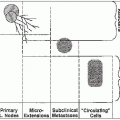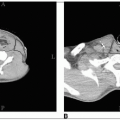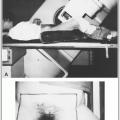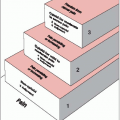AJCC Staging System for Carcinoma of the Urethraa |
Primary Tumor (T) (Male and Female) |
TX |
Primary tumor cannot be assessed |
T0 |
No evidence of primary tumor |
Ta |
Noninvasive papillary, polypoid, or verrucous carcinoma |
Tis |
Carcinoma in situ |
T1 |
Tumor invades subepithelial connective tissue |
T2 |
Tumor invades any of the following: corpus spongiosum, prostate, periurethral muscle |
T3 |
Tumor invades any of the following: corpus cavernosum, beyond prostatic capsule, anterior vagina, bladder neck |
T4 |
Tumor invades other adjacent organs |
Urothelial (Transitional Cell) Carcinoma of the Prostate |
Tis pu |
Carcinoma in situ, involvement of the prostatic urethra |
Tis pd |
Carcinoma in situ, involvement of the prostatic ducts |
T1 |
Tumor invades urethral subepithelial connective tissue |
T2 |
Tumor invades any of the following: prostatic stroma, corpus spongiosum, periurethral muscle |
T3 |
Tumor invades any of the following: corpus cavernosum, beyond prostatic capsule, bladder neck (extraprostatic extension) |
T4 |
Tumor invades other adjacent organs (invasion of the bladder) |
Regional Lymph Nodes (N) |
NX |
Regional lymph nodes cannot be assessed |
N0 |
No regional lymph node metastasis |
N1 |
Metastasis in a single lymph node 2 cm or less in greatest dimension |
N2 |
Metastasis in a single node more than 2 cm in greatest dimension, or in multiple nodes |
Distant Metastasis (M) |
MO |
No distant metastasis (no pathologic M0; use clinical M to complete stage group) |
M1 |
Distant metastasis |
Stage Grouping |
Stage 0a |
Ta |
N0 |
M0 |
Stage 0is |
Tis, Tis pu, Tis pd |
N0 |
M0 |
Stage I |
T1 |
NO |
MO |
Stage II |
T2 |
NO |
MO |
Stage III |
T1 |
N1 |
MO |
|
T2 |
N1 |
MO |
|
T3 |
NO or N1 |
MO |
Stage IV |
T4 |
NO |
MO |
|
T4 |
N1 |
MO |
|
Any T |
N2 |
MO |
|
Any T |
Any N |
M1 |
Primary Tumor |
TX |
Primary tumor cannot be assessed |
TO |
No evidence of primary tumor |
Tis |
Carcinoma in situ |
Ta |
Noninvasive verrucous carcinomab |
T1a |
Tumor invades subepithelial connective tissue without lymph vascular invasion and is not poorly differentiated (i.e., grade 3-4) |
T1b |
Tumor invades subepithelial connective tissue with LVI or is poorly differentiated |
T2 |
Tumor invades corpus spongiosum or cavernosum |
T3 |
Tumor invades urethra |
T4 |
Tumor invades other adjacent structures |
Regional Lymph Nodes (N) |
NX |
Regional lymph nodes cannot be assessedc |
pNX |
Regional lymph nodes cannot be assessedd |
NO |
No palpable or visibly enlarged inguinal lymph nodesc |
pNO |
No regional lymph node metastasisd |
N1 |
Palpable mobile unilateral inguinal lymph nodec |
pN1 |
Metastasis in a single inguinal lymph noded |
N2 |
Palpable mobile multiple or bilateral inguinal lymph nodesc |
pN2 |
Metastasis in multiple or bilateral inguinal lymph nodesd |
N3 |
Palpable fixed inguinal nodal mass or pelvic lymphadenopathy unilateral or bilateralc |
pN3 |
Extranodal extension of lymph node metastasis or pelvic lymph node (s) unilateral or bilaterald |
Distant Metastasis (M) |
MO |
No distant metastasis (no pathologic MO; use clinical M to complete stage group) |
M1 |
Distant metastasise |
Stage grouping |
Stage 0 |
Tis NO |
MO |
|
Ta NO |
MO |
Stage I |
T1a NO |
MO |
Stage II |
T1b NO |
MO |
|
T2,3 NO |
MO |
Stage IIIa |
T1-3 N1 |
MO |
Stage IIIb |
T1-3 N2 |
MO |
Stage IV |
T4 Any N |
MO |
|
Any T N3 |
MO |
|
Any T Any N |
M1 |
a Staging from Edge SB, Byrd, DR, Compton CC, et al., eds. AJCC cancer staging manual, 7th ed. New York, NY: Springer Verlag, 2009, with permission.
b Broad pushing penetration (invasion) is permitted—destructive invasion is against this diagnosis.
c Based upon palpation, imaging.
d Based upon biopsy, or surgical excision.
e Lymph node metastasis outside of the true pelvis in addition to visceral or bone sites. |










